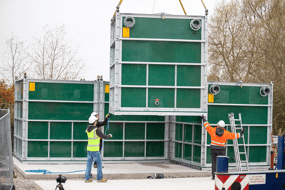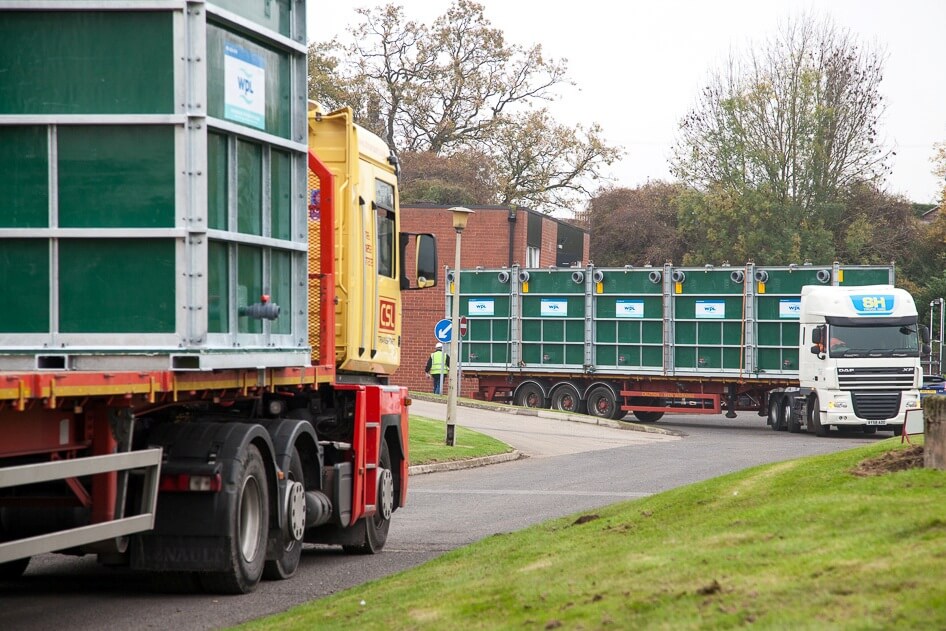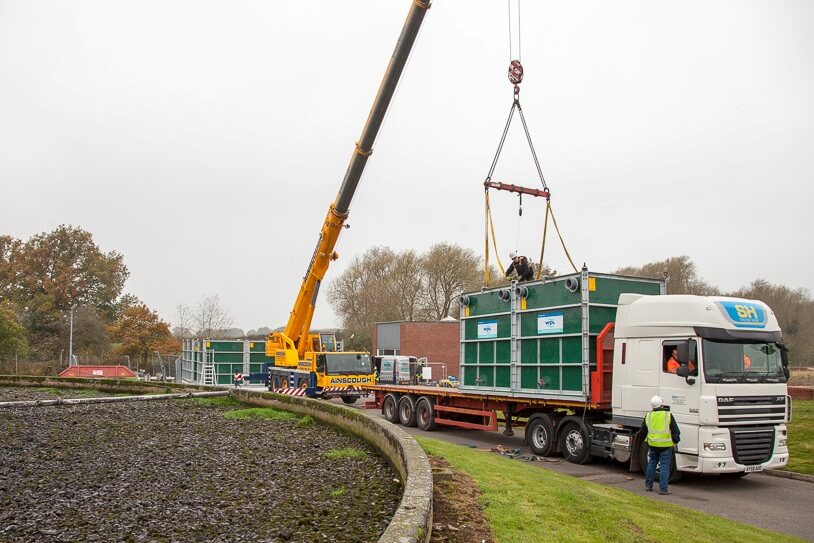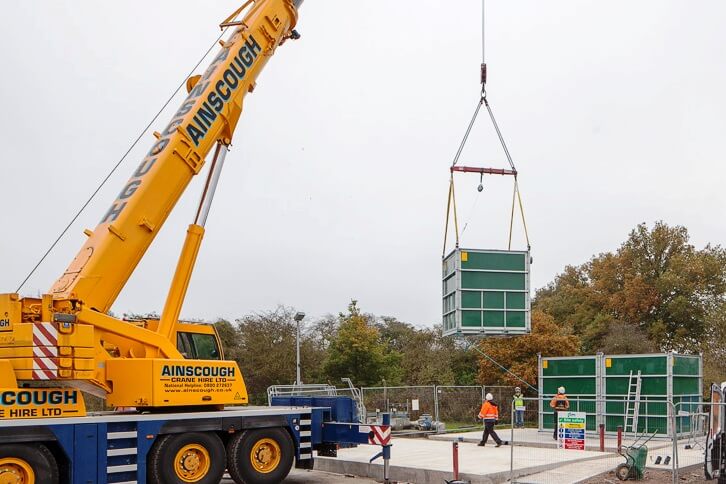We’re on LinkedIn!
Connect with WCS Environmental Engineering Safe Efficient Compliance

The Hybrid-SAF™ (submerged aerated filter) modular wastewater treatment plants has been installed at two United Utilities (UU) sites - Sandbach in Cheshire and Lawton Gate in Staffordshire.
Some 12 Hybrid-SAF modules have been installed in four treatment streams at Sandbach wastewater treatment works (WwTW). Meanwhile, six Hybrid-SAF modules are now providing two additional treatment streams at Lawton Gate WwTW.
Each of the two site installations was delivered and offloaded over two days and was set up and commissioned within five days – Lawton Gate in October and Sandbach in early November 2015 and the plants are likely to be needed at these sites for approximately five years. However, they can be transported from site-to-site as required in the future.
Utility manager Andrew Haywood explained: “United Utilities were very clear about the number of streams they wanted and the need for the SAF units to be transportable. They didn’t want to be left with stranded assets if the requirements of the site changed after five years and saw the flexibility of the Hybrid-SAF as a key advantage.”
The Hybrid-SAF units can operate as individual treatment plants or the modular design means they can be connected in series to form larger plants. The plants are built offsite in a specially controlled environment, which minimises the time required for onsite installation.
The units are lightweight, which means they can be delivered and off-loaded with a Hiab lorry. This flexibility removes the need for large lifting equipment onsite during installation and reduces delivery costs.
The modular nature of the Hybrid-SAF means units can be installed even where sites face height and width constraints. In certain circumstances, we can increase the height or width of individual units at the design stage to accommodate site constraints.

Development the transportable systems was requested by contractor Nomenca as the existing single-stage rock tricking filter plants were experiencing ammonia compliance incidents during low flow and colder conditions. The new plants are required to achieve an effluent quality of 4mg/l ammonia and can be switched off when warmer weather returns – saving energy.
Technical director Andrew Baird said: “In dry weather and colder weather the levels of ammonia in untreated effluent can rise considerably. Last winter United Utilities had to hire additional packaged plants fromus at short notice when the plant at Lawton Gate struggled to cope with the higher levels of ammonia.”
“Rather than having to hire equipment Nomenca and United Utilities decided to upgrade Sandbach and Lawton Gate by adding SAF units.”
The SAF systems have been individually sized to treat the dry weather flow (DWF) for each site: 2,050m3/d for Lawton Gate and 4,000 m3/d for Sandbach. Each stream treats a nominal 1,000m3 wastewater and the additional treatment is expected to be required for three-to-five months a year.
The client specified variable speed drives (VSDs) on the blowers to optimise energy efficiency. The use of VSDs can achieve an energy saving of up to 30% over standard drives.

Design developments focusing on health and safety issues have removed the requirements for high-level access for routine maintenance. The Hybrid-SAF units at Sandbach and Lawton Gate have ground-level sensors and fixed diffusers which remove the need for high-level bubble inspection.
Cutting out the need for operatives to work-at-height reduces the cost of manufacture, installation and maintenance. Importantly, it also reduces onsite health and safety risks.
Andrew Baird said: “Removing top-level access makes maintenance easier and has real benefits in terms of health and safety. New regulations are coming in all the time about high-level working which lead to additional costs and risks for operators.”

Long-term investment
The improved Hybrid-SAF is made of hot-dip galvanised steel and glass reinforced plastic (GRP) with only GRP used below the waterline, ensuring compliance with asset standards. The GRP is UV stabilised with an external gel coating to extend asset life.
The use of GRP in the tank structure has significantly reduced offsite manufacture and assembly time. This means three Hybrid-SAF plants can typically take two weeks to produce, compared with six-to-eight weeks for three steel SAF tanks.
The system can be customised to suit customers’ site-specific requirements for standards on discharge consents, energy efficiency, blowers, physical footprint, installation and cost.
New regulatory guidance for AMP6 (2015-2020) asks English and Welsh water utilities to calculate new investment based on total expenditure (totex) - capital cost plus 20 years’ operational cost. This means utilities are able to invest in new equipment according to whole-life installation and operational costs.
Sales director Simon Kimber says: “We have created the Hybrid-SAF packaged plant in response to our clients’ requirements for AMP6. One of the requirements is for new equipment to be manufactured and engineered off-site as much as possible.
“This cuts down the installation time, reduces the carbon footprint and also reduces the health and safety risks.”
Neil Wilkinson, Projects Manager, Nomenca said: “The modular nature of WPL’s Hybrid-SAFs gives the wastewater treatment plant managers at Sandbach and Lawton Gate flexibility in terms of operation along with the additional capacity required. They can work alongside existing process systems, so they were a good choice at these sites.
“Working in close partnership each process plant was delivered on time and within budget.”
With nutrient neutrality requirements being enforced at off-mains properties in areas of England, homeowners need to ...
Why managing variable loads matters If you have an off mains wastewater treatment system operating at a hospitality, ...
Trade effluents are liquid waste streams discharged into public sewers from businesses and industrial processes. Their ...
Connect with WCS Environmental Engineering Safe Efficient Compliance
WCS Group is a trading name for WCS Environmental Ltd, registered in England and Wales (Number 02184649) at 20 Grosvenor Place, London, SW1X 7HN. Head Office – 17 Wheatstone Court, Waterwells Business Park, Gloucester, GL2 2AQ. WCS Group is a Marlowe Critical Services Company owned by Marlowe plc. 2025© WCS Environmental Ltd.